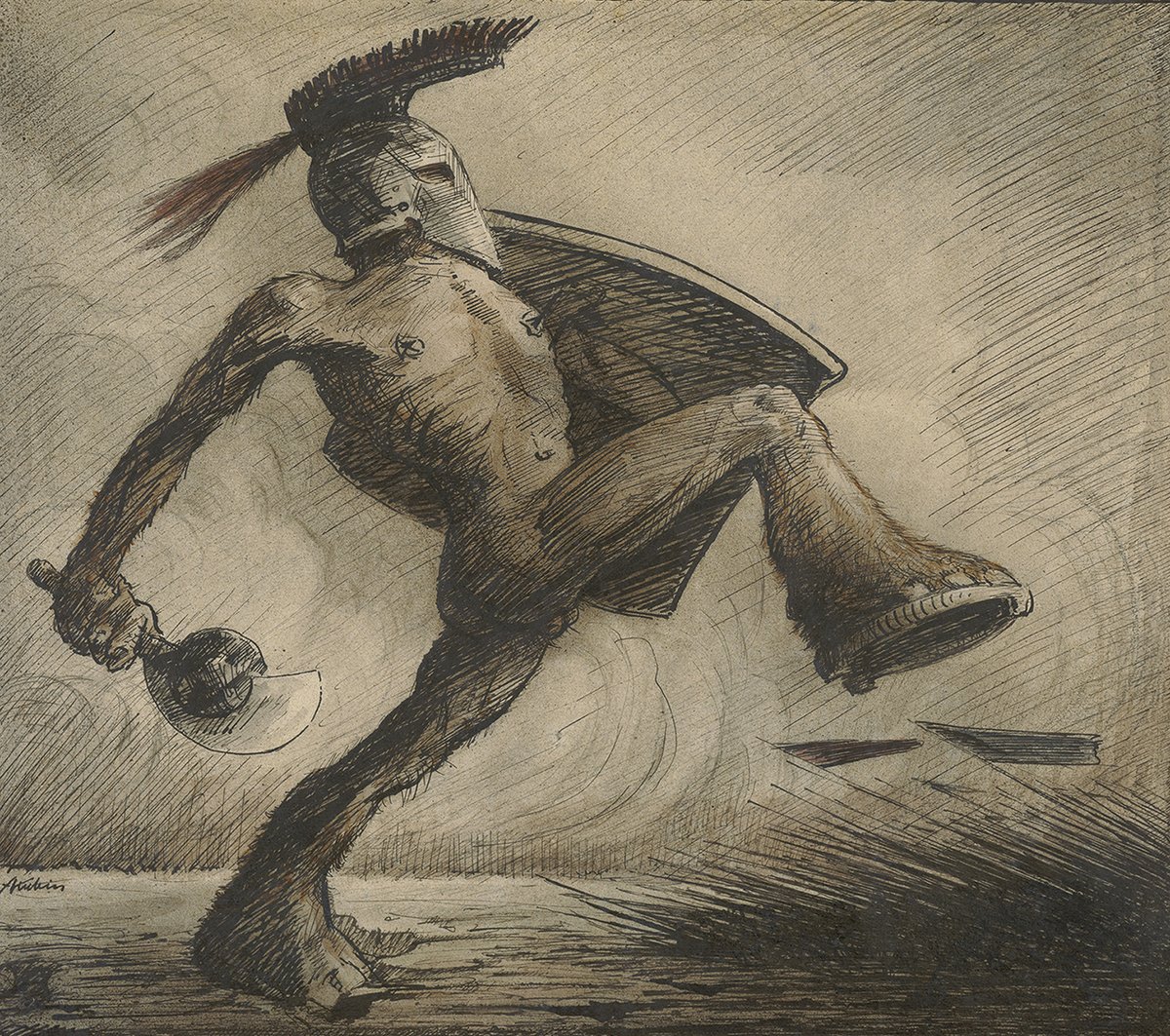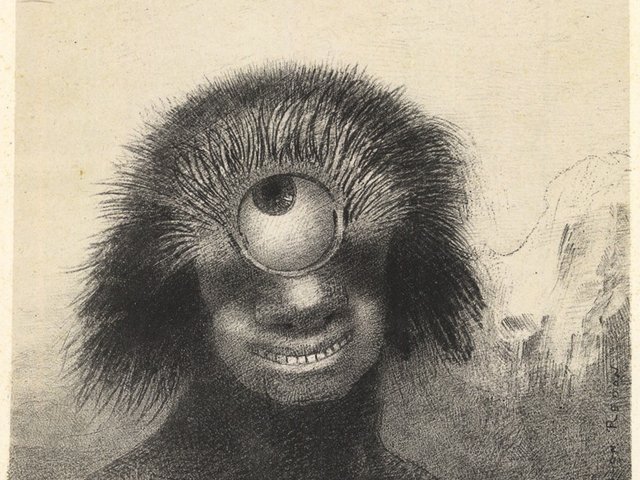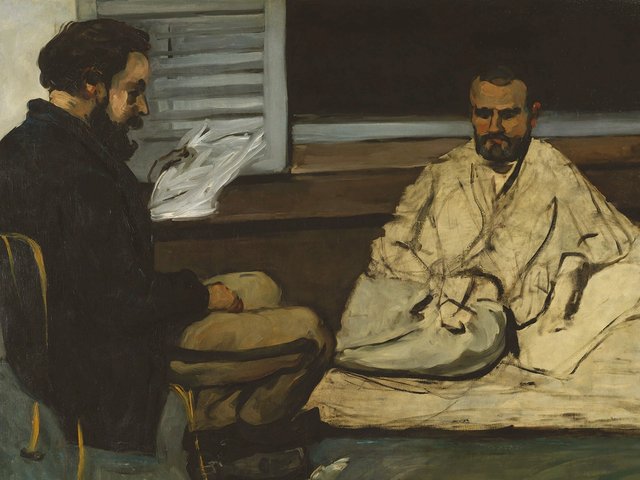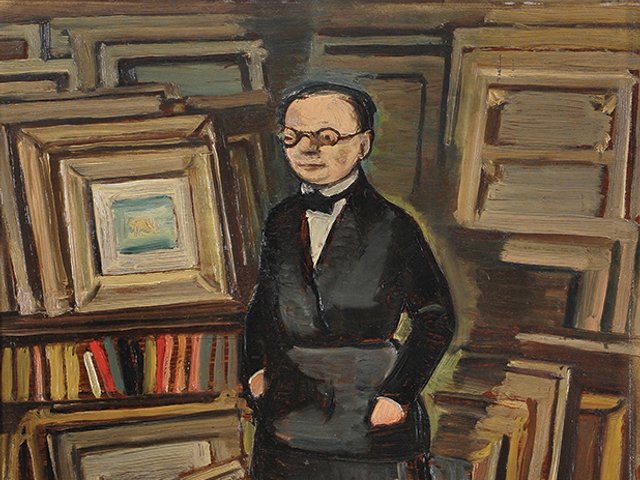An ink drawing printed at the beginning of Alfred Kubin’s 1952 collection Abendrot (evening twilight) shows the artist airborne, attached to a large balloon, thumbing his nose at what he is leaving behind. Since this is Kubin (1877-1959), the incomparable master of the bizarre in his art as well as his writing, we see not only what we would expect, the medieval manor house Zwickledt (his long-time home), but also a large elephant—a creature more likely to appear in a Kubin drawing than anywhere in northern Austria.
There are, it seems, no such opportunities for escape in Kubin’s early works, on display at the Albertina Modern in Vienna (until 11 January). Descending into the museum’s windowless bowels, as I did on a hot Austrian summer afternoon, you will encounter a young artist still firmly in the grip of his demons. An elephant was there, too, having an axe swung against its head by a tiny human (The Butcher, around 1900). The reduced palette of colours used by the curators—the walls are painted either champagne or burgundy, while the mattes used for the pictures alternate between burgundy and eggshell white—enhances the impression that, for as long as you are here, there is no outside to that inside.
Encyclopaedia of horrors
Alfred Kubin: The Aesthetics of Evil is the beautiful catalogue accompanying the exhibition. It faithfully reproduces Kubin’s nascent encyclopaedia of horrors and covers the two decades from 1899 after his abandoned studies at the Munich Academy. During the artist’s early years, tragedy was, as Elisabeth Dutz’s introductory essay reminds us, in abundant supply. At the age of 10, Alfred watched his mother die, only to see his weeping father stagger through the house clutching her limp body. Kubin elder went on to marry, within a year, his dead wife’s sister and, occasional beatings aside, had little time for his son, who also endured sexual abuse at the hands of an older woman. Young Kubin picked up some disturbing habits, torturing small animals or watching the local gravedigger drag the bodies of drowned people from the lake: an experience reflected in Beached Corpse (around 1900), where a waterlogged dead woman, her head grotesquely swollen, has had her hair caught by a branch on the shore. At 19, Kubin tried to kill himself on his mother’s grave, but his rusty pistol jammed.
It is hard not to think of Kubin’s early drawings as personal cries for help. Yet, in the catalogue, the art historian Natalie Lettner emphasises cultural context instead, claiming that Kubin’s reading (Arthur Schopenhauer and Otto Weininger), artistic influences like Francisco Goya and Franz von Stuck, and garden-variety fin-de-siècle misogyny shaped his unflattering portrayals of women. Consider The Egg (around 1900), which features a puppet-like, featureless woman, her pregnant abdomen distended like an insect’s egg sac, standing next to an open grave: womb-as-tomb.
In Kubin’s distorted world, explains Lettner, women seem monstrous simply because of what they are, whereas men turn into monsters only because of what they do: a statement perhaps qualified by a work such as A Dream Visits Us Every Night (1902-03), where a faceless female cyborg with blades for arms and legs, abstract in her inhuman beauty, sails across the night sky, ready to slice into whatever is in her way.

Alfred Kubin’s The Oneberry (1900)
© Eberhard Spangenberg, München/Bildrecht
Knee-deep in a pool of blood
There are, of course, plenty of images of aggressive masculinity in Kubin’s early work. For an excellent example, look at the bushy-mustachioed, muscular executioner standing knee-deep in a pool of blood (The Executioner, around 1899). But for each of those we get several others featuring helpless men hacked to pieces, roasted over a fire or pursued by an army of flying insects with stingers the size of spears. It is clear where Kubin himself felt he belonged. In an early self-portrait, The Weakling (1903), he appears wrapped in a gigantic fur-lined coat, his thin legs stuck in high-heeled boots, a gender-ambiguous Pierrot figure dwarfed by an unidentifiable black shape behind him: a mountain? A pile of dirt?
The real problem, for Kubin, was not gender as much as people. It is sobering to see his prophetic portrayals of war, drawn at the beginning of a blood-soaked century: a devastated landscape littered with crosses (War Game, around 1900); an army of tiny men marching obediently into the gates of Hell (Entrance to Hell, around 1900-01); a giant naked warrior, with one iron-shod, furry foot raised above a sea of miniature spears (War, around 1918). In one of Kubin’s best-known compositions, an illustration of a mass hanging carried out during the Austrian Peasant Wars, two sleek wolves contemplate the gruesome display of bodies dangling from a tree, marvelling at the things humans will do to one another (Hausham Linden, around 1900-01).
Sharply contoured and fully legible, Kubin’s early drawings do not yet have the claustrophobic opacity, deepened by copious hatching and crosshatching, of his later work, where it is often impossible to separate the human figures from their environment. In her essay for the catalogue, the sleep researcher Brigitte Holzinger suggests that Kubin might have found relief from his persistent troubles in psychoanalysis. But Sigmund Freud, Kubin’s near contemporary, believed that our dreams, properly understood, would help us to better live our lives. With Kubin, one cannot be so sure that there is, indeed, a life outside the one made visible in our worst nightmares.
In Kubin’s only novel, The Other Side (1909), an inspiration for Franz Kafka’s The Castle (1926), he has an artist figure very much like himself travel to a city named Perle, the capital of a remote utopian community somewhere in Central Asia called Traumreich (dream realm). Here, the residents, who own only old things and dress in clothes fashionable decades ago, spend their days under a permanently overcast sky. Soon enough, this retrogressive dream world turns out to be a moribund dystopia of the worst kind, a collection of Kubin’s most dramatic fantasies made manifest. Rising up against each other, the “dreamers” destroy the town and themselves. Kubin’s narrator survives by the skin of his teeth, torn, for the remainder of his life, between wanting to die and mindlessly going on with the business of living. He is also no longer able to draw. Which does distinguish him, after all, from his prolific creator, whose one viable escape from his and his century’s pervasive fears—no fancy balloons needed—was to keep reimagining them.
• Alfred Kubin: The Aesthetics of Evil, Elisabeth Dutz (ed), Steven Lindbergh (trans), Hatje Cantz, 232pp, 180 col and b/w illustrations, £44 (hb), 5 September 2024





